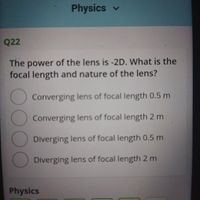Question

Transcribed Image Text:Physics v
Q22
The power of the lens is -2D. What is the
focal length and nature of the lens?
Converging lens of focal length 0.5 m
Converging lens of focal length 2 m
Diverging lens of focal length 0.5 m
Diverging lens of focal length 2 m
Physics
Expert Solution
This question has been solved!
Explore an expertly crafted, step-by-step solution for a thorough understanding of key concepts.
Step by stepSolved in 2 steps with 2 images

Knowledge Booster
Similar questions
- For a converging lens, the object lies 13 cm from the lens and the image is 21 cm from the lens on the opposite side. What is the focal length of the lens? Your Answer:arrow_forwardThe projection lens in a certain slide projector is a single thin lens. A slide 23.7 mm high is to be projected so that its image fills a screen 1.71 m high. The slide- to-screen distance is 3.02 m. (a) Determine the focal length of the projection lens. mm (b) How far from the slide should the lens of the projector be placed to form the image on the screen? mmarrow_forwardFor a converging lens, the object lies 15 cm from the lens and the image is 34 cm from the lens on the opposite side. What is the focal length of the lens?arrow_forward
- An object is placed 27 cm in front of a diverging lens having a focal length of magnitude 65 cm. What is the image distance, in cmarrow_forwardUsing a single optic with a positive focal length, an image is created. As a result, which of the following MUST be true? Choose all that apply. The image is real The image is virtual The image is inverted O The image is upright The image distance is positive The image distance is negative The image height is positive The image height is negative The image has a positive magnification The image has a negative magnification The optic is converging The optic is divergingarrow_forwardA diverging lens with focal length |f = 18.0 cm produces an image with a magnification of +0.620. What are the object and image distances? (Include the sign of the value in your answers.) cm cm object distance image distancearrow_forward
- The distance between the objective and eyepiece lenses in a microscope is 21 cm . The objective lens has a focal length of 5.0 mm . What eyepiece focal length will give the microscope an overall angular magnification of 350?arrow_forwardYou have a lens whose focal length is 12.9 cm. You place an object on the axis of the lens at a distance of 6.27 cm from it. How far is the object's image from the lens?arrow_forwardA diverging lens is located 14 cm to the left of a converging lens. A 3.44-cm-tall object stands to the left of the diverging lens, exactly at its focal point. Determine the distance of the final image relative to the converging lens, in cm. Diverging lens 1 focal length = -7 cm Converging lens 2 focal length = 32 cm Object F1 Lens 1 Round to nearest whole number Lens 2 Eye Aarrow_forward
- You have a thin, diverging lens. If the value of q (the distance from the image to the mirror along the principal axis of the mirror) is -3.57cm and the distance of p (the distance from the object to the mirror along the principal axis of the mirror) is 17.16cm, what is the focal length of the diverging lens? Object Ray 1 Principal focal point Virtual image Diverging lens Ray 1 Ray 3 Ray 2 Secondary focal point |fl ·|fl· Note: Do not explicitly include units in your answer (it is understood the unit is cm). Enter only a number. If you do enter a unit, your answer will be counted wrong.arrow_forwardA lens with a 0.98 meter focal length is placed right in front of a -3.6 meter focal length. A small object is placed 1.6 m in front of the two lenses. What is the magnification of the image formed by the two lenses? The space between the lenses is minuscule.arrow_forwardThe objective lens of a microscope is a planoconvex (flat on one side) lens that has a short focal length of 7.6 mm. The focusing knob on the microscope moves the object toward or away from the objective lens. The microscope is designed so that the object will be seen in focus through the eyepiece when the objective lens forms a real image of the object 160 mm behind the objective lens. (a) At what object distance in mm is the microscope focused? (b) What is the lateral magnification of the objective lens?(c) Account for the resulting image shown in the figure, i.e. using your calculations, justify that indeed the image is real, magnified, and inverted.arrow_forward
arrow_back_ios
SEE MORE QUESTIONS
arrow_forward_ios